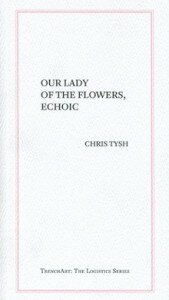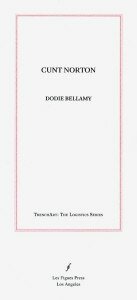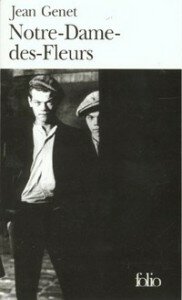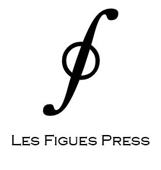OUR LADY OF THE FLOWERS, ECHOIC
BY CHRIS TYSH
LES FIGUES PRESS, 2013
CUNT NORTON
BY DODIE BELLAMY
LES FIGUES PRESS, 2013

1. Pins Ups: Covering the Classics
“I realized early on that the academy and the literary world alike — and I don’t think there really is a distinction between the two — are always dominated by fools, knaves, charlatans and bureaucrats.’
– Harold Bloom in an interview in Criticism in Society (1987), edited by Imre Salusinski
The literary landscape is a sensitive thing. One has to be careful, especially if loaded words are used. Originality. Authenticity. The Western Canon. Les Figues Press throws a wrench into those hallowed notions with two new poetry collections, Our Lady of the Flowers, Echoic, by Chris Tysh, and Cunt Norton, by Dodie Bellamy. The first is a poetic re-interpretation of Jean Genet’s erotic classic, Our Lady of the Flowers. (This reviewer counts Our Lady of the Flowers as one of his three favorite books of all time.) Cunt Norton is a cut-up of the Western Canon of primarily English and American male writers, interspersed with pornographic prose.
With the rise of fan fiction, strange literary adaptations (Android Karenina, etc.), and posthumous resurrections of abandoned works (The Pale King, The Original of Laura, etc.), literature now seems to lack a certain something. Sacredness? Separateness? Specialness? More draconian copyright laws?
Why? Who says so? Since when has literature been stuck in amber and impervious to creative subversion? Ulysses, by James Joyce, and The Odyssey: A Modern Sequel by Nikos Kazantzakis jump immediately to mind. Even the Romans stole the mythology of the Greeks on their way to forging a global empire. Perhaps the fetishizing of the Creative Work Innate Inalienable Unalterable Specialness (in caps, natch) is rudimentary to the dictatorial mind? Just look at Samuel Beckett and David Mamet. The way they control their artistic works leans a bit on the fascist side; dramatic interpretations the envy of every unreconstructed Stalinist. Want to throw a spork into the Beckett Estate? Adapt Waiting for Godot using female leads.
Happily, Our Lady of the Flowers, Echoic, and Cunt Norton can both be seen as positive, life-affirming acts of artistic terrorism.
In addition to this fan-fictional democratization of literature, the phenomenon of covering a song isn’t exactly new. But that is music, and this is poetry. It’s one thing for Hendrix to cover Dylan, but for another poet to “cover” Jean Genet? This is most confounding. Not since Jorge Luis Borges had Pierre Menard write Don Quixote has there been a more perplexing situation for literary connoisseurs. (I’ll delve into the particulars of genre theory in a later section.)
One sees this same debate in law. Is the American Constitution an ever-changing, ever-evolving document that requires modern interpretations to meet the needs and challenges of a modern, pluralistic, secular democracy? Or is the Constitution an Eternal Vessel of Truth and Morality that should be guarded by an elite magisterium of prayerful heavenly emissaries charged by God with keeping these Eternal Verities unchanged, unaltered, and unsullied by the poisonous tentacles of modernity?
Let’s put a pin in that.
Our Lady of the Flowers, Echoic, by Chris Tysh “covers” Jean Genet’s novel. The surprising thing is that no authorial gloss is overlaid. No witty commentary or postmodernist machinery. The Wind Done Gone it ain’t. The more amazing thing is that Tysh has successfully distilled Genet’s novel, boiling down several hundred pages into 134 pages of crisp seven line stanzas. And Les Figues has formatted it so that there is a close to 50% white space.
What further complicates this creative strategy is that Our Lady of the Flowers is a poetic novel to begin with. It is a monument to gender fluidity, non-linear narrative, and public artifice; gender as performative to cite the oft-cited Judith Butler. Genet renders the gutter queens, stool pigeons, murderers, and pimps are rendered in haunting prose. Tones switch like gender, from hard-boiled street tough to gossipy queen, from sexually explicit to poetically lyrical. The artistic challenge seems daunting. Is it a “cover version” of Our Lady of the Flowers? The answer: sort of. But covers usually reinterpret the original source material somehow, transpose genre, etc. Tysh renders the prose of the novel into poetry, although the transposition of prose into poetry involves a lot of distillation, since Our Lady of the Flowers, Echoic, is far shorter than the original novel. So what does Chris Tysh call what she did? The answer: transcreation. In Tysh’s words, transcreation is:
“A cross-cultural communication between continents, languages, and temporalities, which prolongs the life of the original like a standard translation does, but at the same time ushers in a gap and a movement away from the generating cell. In ghostly fashion, the new poem is haunted by its French progenitor, while allowing itself to cross over into a totally new temporality and formal structure.”
It is naming this “gap and movement” with a term that seems so perplexing and infuriating to the Stasi of the literary status quo. Chris Tysh’s transcreation attends to transcend the concepts of adaptation, parody, and the cover song.
Our Lady of the Flowers, Echoic, is not the first time Tysh has “covered” a classic from the Western Canon. This volume is a sequel (of sorts) to Molloy: the Flip Side. The project’s third volume will involve a work by Marguerite Duras.
2. The Norton Anthology of Poetry (The Pornographic Version)
Hamlet: Lady, shall I lie in your lap?
Ophelia: No, my lord.
Hamlet: I mean, my head upon your lap?
Ophelia: Ay, my lord.
Hamlet: Do you think I meant country matters?
– Hamlet (William Shakespeare, 1602)
Teddy Bass: (raising a glass) Gentlemen! You’re all cunts.
-Sexy Beast (Jonathan Glazer, 2000)

Say it with me. All together now. Cunt.
Latin for vagina, the c-word still resonates with a thermonuclear power. While basic cable has become the playground for the occasional “fuck” and “shit” (“damn” and “bitch” are now almost commonplace), “cunt” retains its power to shock.
Cunt Norton’s greatest irony emanates from the how joyous it is to read. The cut-ups of the Western Canon and the pornographic move beyond its programmatic artifice and become a sort of liberation. Words, liberated from the castrating idiocracy of speech codes and middlebrow propriety, fly and burn with a beautiful intensity:
Open thy temple gates and fuck my cock. My poste adorne as doth behove, as thy chest I adorne with come. Recyve my saynt with honour dew; drive it in any direction thou direction thou want’st til in humble reverence thou commest. (Cunt Spenser)
The delivery is graphic and the situation carnal, not at odds, but in concert with the genuine emotions and intimacy. Patton Oswalt in his bit, Clean Filth, relates how “creepy, G-rated filth is way more disturbing than regular filth.” Once cleaned up, it the G-rated filth sounds like something a serial killer would say.
Cunt Norton also includes authors known for their vulgarity, including Chaucer, Whitman, and Ginsberg, further complicating its critique of literary pedagogy. There’s an obvious reason I included the Hamlet dialogue where the tortured Dane prince makes a cunt pun. Hamlet is held as the apogee of the Western Canon. (Damn rightfully, I might add.) But sitting alongside the monologues about being, spirituality, and death, the play slathers on the sex and violence.
Cunt is a word that is also geographically contingent. On American shores, the term is obscene and can cause spontaneous hysteria. In the United Kingdom both underworld slang and Polari (an English subcultural slang used by the gay community for centuries) use the term a lot. Sexy Beast and the Cockney clockworks of Guy Ritchie (Lock, Stock, and Two Smoking Barrels and Snatch) pepper the dialogue with “cunts.” In the case of Sexy Beast, the term is an equivalent of “mate,” or for Americans, “dude.” “Cunt,” like “dude,” has numerous iterations and shades of meaning depending on the tone, context, and nuance of the speaker and the relationship to the listener.
To quote Teddy Bass (played with icy menace by Ian McShane), “Gentlemen, you’re all cunts.”
3. So what is it then?
“To achieve harmony in bad taste is the height of elegance.”
–The Thief’s Journal (Jean Genet, 1949)
What is Our Lady of the Flowers, Echoic?
Is it a parody like The Wind Done Gone, by Alice Randall? (A reinterpretation of a classic work, in this case, Gone With the Wind.) The answer: No.
Is it a sequel done in the style of the original like The Odyssey: A Modern sequel, by Nikos Kazantzakis? The answer: No.
Is it a cut-up of the original source material with other material like Cunt Norton? The answer: No.
Is it a witty postmodernist take on Our Lady of the Flowers? The answer: Not exactly. Tysh takes no narrative liberties with the original story. No addition of modernist snark or politically correct scolding.
Is it a postmodernist stunt like Pierre Menard, Author of the Quixote, by Jorge Luis Borges? The answer: No. “Those who have insinuated that Menard devoted his life to writing a contemporary Quixote besmirch his illustrious memory. Pierre Menard did not want to compose another Quixote, which surely was easy enough – he wanted to compose the Quixote.” Our Lady of the Flowers, Echoic lies somewhere between another Our Lady and the Our Lady.
Between the conception
And the creation
Between the emotion
And the response
Falls the Shadow
– The Hollow Men, (T. S. Eliot, 1925)
4. The Artifice of Authenticity and the Authenticity of Artifice
Prior: It was tacky.
Belize: It was divine.
He was one of the Great Glitter Queens. He couldn’t be buried like a civilian. Trailing sequins and incense he came into the world, trailing sequins and incense he departed it. And good for him!
Prior: I thought the twenty professional Sicilian mourners were a bit much.
–Angels in America: Part Two: Perestroika (1992, Tony Kushner)
It seems paradoxical that authenticity can come across as artificial and artifice can seem authentic. The notions that authenticity means “true and good,” and artifice means “bad and false” have been so hard-wired into the human consciousness that it remains a challenge to successfully eradicate. It is strange seeing RuPaul in mufti. Equally strange seeing ruling class career politicians strap on the proletarian drag of denim shirts and blue jeans to clear brush. Is that Michael Dukakis riding a tank? What the actual fuck?

In Our Lady of the Flowers, Jean Genet tells the life story of Divine. In the process, he creates one of the greatest figures in twentieth century literature. Divine, a drag queen, falls in love with a stool pigeon, has affairs with murderers, and dies of tuberculosis. Genet creates an alchemical admixture for Divine’s life, intermixing Catholic splendor with lowbrow gutter criminality. Chris Tysh recaptures this alchemy in her short poetic stanzas:
Than a phantom shadow
Tinged with blue while outside
Let’s say under the blue canopy
Of tiny umbrellas, Mimosa I,
Mimosa II, Mimosa half-IV,
First Communion, Angela. Her
Highness, Castagnette and Régine
Await holding sprays of violets
All the queens, boys and girls
Are there knotted together chattering
And tweeting, pearl tiaras on their heads
I let myself sink to my own village grave-
Yard where snails and slugs leave
Trails of slime on what flagstones[.]
It’s an almost-transcription of Genet’s prose. Divine, acquiring the clothes and mannerisms of women, becomes a monument of artifice. An alias that transcends her biological formatting. But in this artifice Divine becomes her true self.
Ironically, attempts at authenticity can ring false. Nothing smacks of intellectual bankruptcy more than those attempting to be authentic, then failing with the transparency they allegedly seek. When one’s authenticity is outed as false, one is left being nothing more than a poseur. It is posture without any underlying meaning. The grassroots acoustic guitar playing crunchy granola activist is simply another pose. No more artificial or ill-intentioned than a drag queen. But what are the intentions? Is Mr. Crunchy Granola really mean it, or is he donning the raiment of leftist activism to get laid? One also sees virulent homophobes donning drag to ridicule gays. The challenge remains to see below the surface and have the courage to call bullshit on the fakers.
The best artifice is effortless, done with ease and grace. Does the argot of queens ring false to public ears because the heteronormative pose has become so ingrained and so omnipresent society barely notices it? And is the hyper-feminized speech and gestures of queens any less ridiculous than, say, the macho posturing one sees in all-male environments like man caves, locker rooms, and Promise Keeper gatherings? (Insert joke about Republican gay sex scandals here.)
The artifice sets queens apart. Belize nails it when she says that the queen “couldn’t be buried like a civilian.” The queen is like a soldier, another group set apart from civilian life by the uniform. The soldier has camouflage and medals for valor. The queen has glitter and sequins. Artifice is the source of Divine’s transcendent power as a literary figure:
Each stolen object: liquor, perfume,
Fake jewelry, give the room its
Mysterious allure like flashing
Lights on a distant ship. Parked car
Or friend’s pocket, Mignon will boost
Anything anywhere and D will simply
Say, I feel like praying on his bare chest
On Sundays they go to mass, gold
Clasp missal in D’s hand, clickety-
Clack they kneel on plush pews
And let a mean-looking priest
Cram the host into their mouths
“Our Mother Who Art in Heaven,”
They pour out in unison, bow down
To the splendor of the pious world
At home.
Our Lady of the Flowers, Echoic, artifice reflects against the artifice of Genet’s original. It is a postmodern refraction of an early postmodern novel. Chris Tysh has transcreated an artifice that rings true and will stand up against the faux-authenticity that became so popular after 9/11. The New Sincerity, like “reality shows” and literalist Bible interpretations, reek of falseness, disingenuousness, and intellectual bankruptcy. Nothing is more fake than announcing how authentic you are? You can’t boast about your humility either.
Despite appearances of poetical stenography, Our Lady of the Flowers, Echoic, is much more than a “cover” version of an original.
5. The Future of Poetry
“Written poetry is worth reading once, and then should be destroyed. Let the dead poets make way for others. Then we might even come to see that it is our veneration for what has already been created, however beautiful and valid it may be, that petrifies us.”
–The Theater and Its Double (Antonin Artaud, 1938)
Les Figues Press has given the reading public two fascinating examples of experimental poetry. Despite the postmodernist approaches both have, each goes beyond mere stunt or artifice. One creates originality from imitation and the other uses cut-ups to affirm the very source material it cuts. All literature is there for the taking. Literature can be imitated, parodied, subverted, and perverted. Because the Western Canon is such a valuable reliquary of human achievement, that’s the reason to manipulate it and warp it, depending on the whim of the artist. Literature isn’t something that should be paralyzed by stasis or by worshipful fans. Android Karenina really isn’t my thing. I will probably never buy it or read it, but calls of “literary grave-robbing” and “shameless cash grabs” seem a bit too bombastic.
Then there are the Chapman Brothers drawing clown faces on Goya’s Disasters of War. As one who loves the Chapman Brothers and Francisco Goya, I’m still conflicted. They defaced Goya’s originals for their artistic project. Although that is hardly the same as the museum attendee who attacked Michelangelo’s Pieta with a sledgehammer. His insanity is beside the point, since his act of artistic vandalism was no different than the Taliban destroying the twin Buddhas of Bamiyan. But artistic defacement and destruction goes back to the dawn of mankind. Muslims painting over the mosaics of Hagia Sophia; prudes lopping off genitalia of Greco-Roman sculptures; iconoclasm (the movement, not the pose); and so on. The examples are limitless. And yet, and yet! Is defacement different when an artist does it to further their artistic project than some narrow-gauge fanatic doing the same to further their political, ideological, or religious ideals? (Calling the act “defacement” also loads the deck and biases the answers.) We are mutable and we are mortal. When art shows us our limitations and the boundaries of this too, too solid flesh, some have taken it as a cue to go all “Hulk smash!” on things. If a museum fire destroyed numerous Thomas Kinkade originals, would we care? Should we care?
Taste is a fickle beast. And arguments about the merits or demerits is warranted and should be encouraged. Hysterical outbursts, generalized statements, and overly dramatic hang-wringing seems to me, at least, as declassé. Android Karenina as literary necrophilia? Girlfriend, please! How, pray tell, do you describe actual disasters, like the Rwandan genocide, Slobodan Milosevic’s ethnic cleansing, and Abu Ghraib? Before one opens one’s yap on a discussion thread, how about putting things in perspective first? Using language like that degrades language and defangs the power of language to describe horrific events. Using the same language to describe Android Karenina and, say, NSA domestic wire-tapping, is crass and obscene.
Luckily there is Les Figues, ready to throw a wrench into the hallowed pretensions of cautious middlebrow culture warriors. The world is a better place with this press in it.








